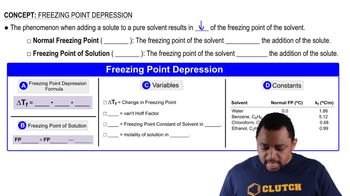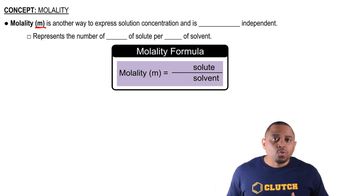Here are the essential concepts you must grasp in order to answer the question correctly.
Freezing Point Depression
Freezing point depression is a colligative property that describes the decrease in the freezing point of a solvent when a solute is added. The extent of this depression is directly proportional to the molality of the solute and the freezing-point-depression constant of the solvent. This relationship is expressed by the formula ΔTf = Kf * m, where ΔTf is the change in freezing point, Kf is the freezing-point-depression constant, and m is the molality of the solution.
Recommended video:
Freezing Point Depression
Molality
Molality (m) is a measure of concentration defined as the number of moles of solute per kilogram of solvent. It is particularly useful in colligative properties because it accounts for the mass of the solvent rather than the volume, which can change with temperature. In this problem, calculating molality is essential for determining how much the freezing point is lowered due to the addition of naphthalene to camphor.
Recommended video:
Molar Mass Calculation
Molar mass is the mass of one mole of a substance, typically expressed in grams per mole (g/mol). To find the molar mass of naphthalene in this scenario, one must first determine the number of moles of naphthalene using the freezing point depression data and the known mass of naphthalene. The molar mass can then be calculated by dividing the mass of naphthalene by the number of moles derived from the freezing point depression equation.
Recommended video:
Molar Mass Calculation Example




